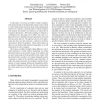47 search results - page 8 / 10 » Three Dimensional Segmentation of Intravascular Ultrasound D... |
ARTMED
2006
13 years 6 months ago
2006
Medical assessment of penetrating injuries is a difficult and knowledge-intensive task. Physical examination and computed tomographic (CT) imaging data must be combined with detai...
CGF
2006
13 years 6 months ago
2006
The most important technique to visualize 3D scalar data, as they arise e.g. in medicine from tomographic measurement, is direct volume rendering. A transfer function maps the sca...
SIGGRAPH
1996
ACM
13 years 10 months ago
1996
ACM
This paper describesthe application of spacetime constraints to creating transitions between segments of human body motion. The motion transition generation uses a combination of ...
MICCAI
1999
Springer
13 years 10 months ago
1999
Springer
We present a new approach for the computation of the deformation field between three dimensional (3D) images. The deformation field minimizes the sum of the squared differences b...
CGI
1998
IEEE
13 years 10 months ago
1998
IEEE
In this paper we present an indirect volume visualization method, based on the deformable surface model, which is a three dimensional extension of the snake segmentation method. I...

